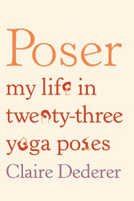The Evolution of a Book Cover Concept

Seasoned art director Charlotte Strick struggled to find right visual balance when designing "Poser" book cover.
In an article for The Atlantic, Charlotte Strick, a seasoned art director for publishing house Farrar, Straus and Giroux, discusses the evolution of a book cover design from initial ideas to final concept. During her 11 years working for the publisher, the designer has grown adept at taking general or amorphous direction from editors and creating innovative solutions. But when she was tasked with designing the jacket for Claire Dederer’s book Poser: My Life in Twenty-Three Yoga Poses, she faced a unique challenge. Strick’s personal interest in yoga fuel her excitement about the project, but her initial idea of photographing propped up silhouettes of people in yoga poses spelling out P-O-S-E-R did not turn out as anticipated. “In my mind’s eye the concept looked brilliant, but in reality it was all too fussy and totally unreadable. What was clear early on was that the photographs of the posing women were too literal and that illustration would not only add a playfulness (in keeping with the author’s tone) but also allow for increased (if not somewhat superhuman) flexibility in the letterforms,” she writes.
The art director then had illustrator Chris Silas Neal render the posing figures, but she still struggled to strike the right balance with the design. “Interestingly, a gender divide within our company emerged. Around the office it seemed that the men could not immediately read the illustrated title and thought it was too much work to ask of the consumer, while the majority of women enjoyed the visual challenge.”
Different illustrative and photographic approaches were contemplated over several weeks, but Strick kept circling back to her original idea. “I revisited the pile of printouts of possible solutions from the preceding months, when it dawned on me that it was really the subtitle, My Life in Twenty-Three Yoga Poses, that was doing the work to sell this book. If I interspersed Chris’s hand-drawn women with actual letterforms, one’s brain didn’t have to work quite as hard to sort out the graphic wit. By setting the subtitle as large and as visually important as the title, I felt I finally had a winning solution. With my newly conceived layout in hand I marched upstairs to present it. The editor actually giggled when she saw it. And so another jacket design puzzle was solved.”

